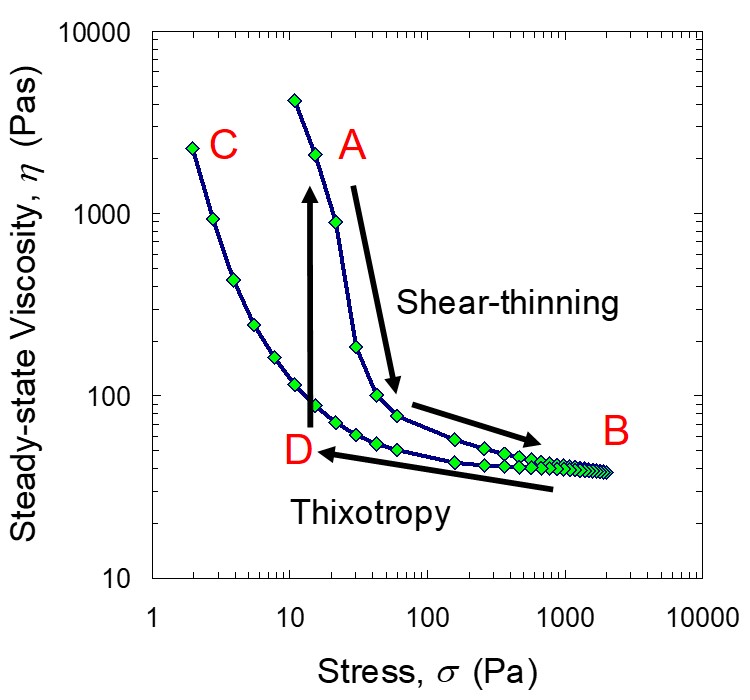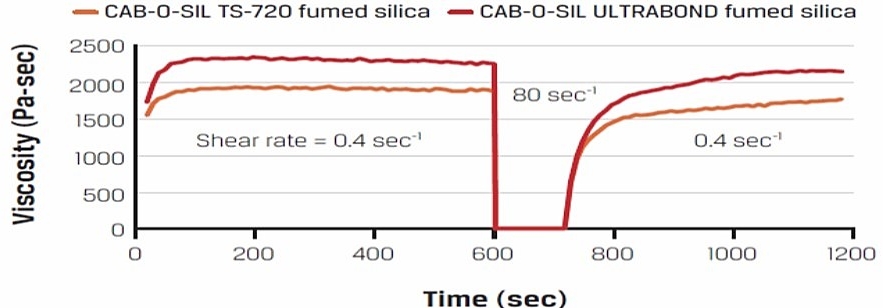The last post provided an introduction to the mechanism of rheology modification using fumed silica. This post will expand on that discussion and provide more insights into the shear thinning and viscosity recovery process.
Figure 1. Viscosity as a function of shear stress for a fumed silica filled epoxy resin.
Figure 1 clearly shows the viscosity decreases dramatically with shear stress during an increasing stress sweep (upper curve from A to B). However, after shearing and during a decreasing stress sweep, the viscosity does not follow the initial viscosity curve. Looking at the images at the top of this post provides some insights. During the first shearing run, the fumed silica 3-dimensional network is broken down into agglomerates resulting in a lower viscosity. With decreasing shearing, the particles will begin to agglomerate again, slowly developing a 3-dimensional network.
During the decreasing stress sweep in Figure 1, the stress was reduced to about 2 Pa (point C). Note the viscosity reaches a similar level (in the range of 2500 Pas) but the yield point of about 2 Pa is lower than the original approximate yield point of 10 Pa (at A). An explanation for the lower yield point is that the 3-dimensional fumed silica network has not had enough time to fully form again. If in Figure 1, the decreasing stress sweep was stopped at D and let to rest over time, the viscosity would increase to the level at A due to the re-building of the 3-dimensional network. In the same manner, if you completed the stress sweep at point C and let the material rest, as the fumed silica network built, the yield point would move towards the original yield point at A.
Let’s talk about thixotropy. A polymer or polymer/filler mixture that is dependent on time is termed thixotropic. Sometimes shear thinning is confused with thixotropy. For example, unfilled polyethylene in the melt will have a decreasing viscosity at high shear rates (i.e. shear thinning), but will not typically exhibit time dependence, that is if the shear rate is decreased, the same viscosity shear rate curve will be obtained. On the other hand, many highly filled formulations exhibit time dependency in that once the filler network or the particle-particle interactions are broken down during shearing, the network structures take time to rebuild. The time-dependence was clearly seen in Figure 1.
An interesting question is how to run a “recovery” experiment? The next section will describe an experiment run by Cabot to demonstrate the recovery of CAB-O-SIL® fumed silica.
Figure 2. Viscosity as a function of time for epoxy resin and polyamide curing agent with 5.4% fumed silica loading (reference [1])
The data in Figure 2 is from a formulation that contains 5.4% fumed silica by weight in a mixture of Hexion EPON® 828 epoxy resin and Air Products and Chemicals Ancamide® 351A curing agent. Two fumed silica’s were used; CAB-O-SIL® TS-720 and CAB-O-SIL® UL ULTRABOND.
The shear recovery experiment was conducted in the following manner. At the beginning of the experiment, the viscosity was measured at a low shear rate of 0.4 sec-1 for 600 seconds. After the initial startup, the viscosity for both of the fumed silica formulations maintained a steady viscosity. At time=600 seconds, the shear rate was stepped to 80 sec-1 and the formulations were sheared for approximately 100 seconds. At time=700 seconds, the shear rate was stepped back to the initial shear rate of 0.4 sec-1. Immediately after the shear rate was decreased to a very low (but finite) value, the viscosity began to steadily increase. There was a large initial viscosity recovery in about the first 100 seconds, followed by a slow viscosity increase out to 1200 seconds.
Examination of the viscosity recovery shows for the TS-720, after the first 100 seconds, the viscosity recovered approximately 80% of the initial viscosity (1500 Pas/1900 Pas). Another feature is also observed. At the same fumed silica loading, the UL ULTRABOND had a higher initial viscosity but recovered at approximately the same rate as the TS-720 indicating the choice of fumed silica can be used to tailor the initial viscosity while maintaining a fast viscosity recovery after shearing.
The next post will discuss the role of surface chemistry on the rheological properties.
References




Leave a Reply